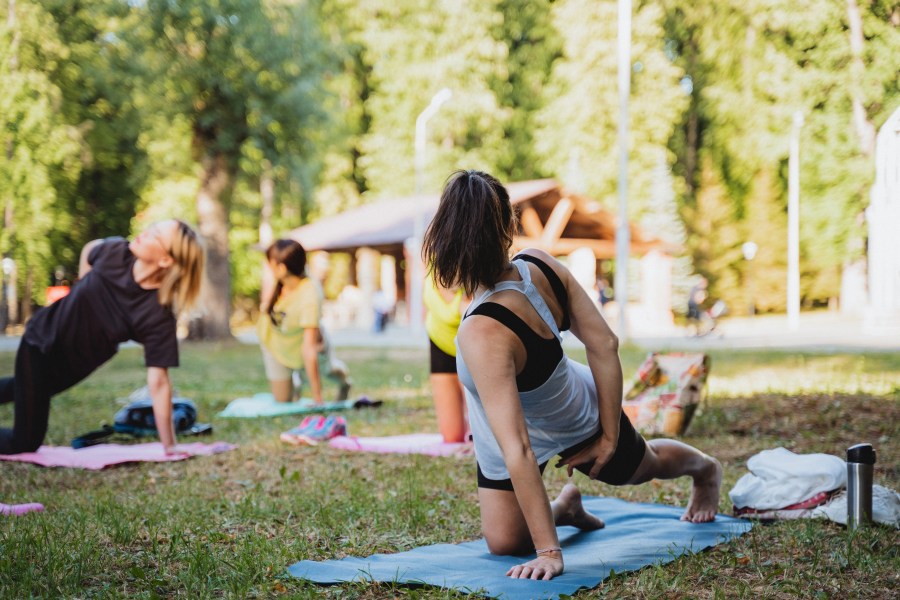The Yoga Guy at The Fitness Group, the UK’s leading training provider, explores how Park Yoga aims to connect and reconnect people to the natural outdoors.
It’s beautiful to practise yoga in the great outdoors. There’s fresh air, a gentle breeze and warm sun, surrounded by open grassland, nearby trees and, if you are lucky, a body of water. It’s all natural – a perfect antidote to office work, driving a car, collapsing in a chair, and generally being sedentary.
What is Park Yoga?
Yoga means union. The union of body and mind, and of good health and wellbeing. Park Yoga charity is creating a variety of settings around the country to enable participation in an environment that gives people the confidence and encouragement to engage with the processes of yoga.
So far, there are 33 communities across England that are signed up to the series of Sunday events run by the Park Yoga charity, pushing the wellbeing community on a national scale. Park Yoga sessions are free and accessible, and all are welcome regardless of age, background or ability – and there is no need to book! The Park Yoga organisation intentionally offers free classes so that money is removed as an obstacle for participation – simply find your local participating park and turn up.
What are the benefits?
There is a tremendous sense of freedom and uplift that comes with both Park Yoga and ‘wilderness’ yoga. It’s super for mental health, and being part of a collective, all moving and breathing together, reinforces feelings of belonging and an affiliation to something that goes beyond your work or family life. It engages your thoughts and attention on your internal body sensations, helping you escape from the mundane.
It uses the asanas (postures) to amplify any signals from your body through its use of breathing techniques. There is also the idea that it helps rediscover your true self as you reconnect the brain, the neural network and the muscles, so your whole psychological and physiological systems begin to connect. For some, there is a spiritual connection, too – all of which is reinforced by being outside and in the open air while practising breathwork. And as a result, it creates a positive ripple effect and improves the wellbeing of those in its communities.
There are several physical benefits, too, that go beyond strengthening and mobilising joints and muscles. These include lowering breathing and heart rates, using the full range of mechanics for breathing, developing the tolerance of CO2, and challenging the body to become more efficient at gaseous exchange. There is also a stimulation of the parasympathetic (‘rest and digest’) nervous system to aid relaxation and restfulness, giving full effect to the power of catharsis.
What is a typical class like?
You’ll need to take your own yoga mat (or two, if the ground is a bit bumpy!), and arrive hydrated, ideally having eaten something light around 90 minutes before the session. Take water with you, so it’s available during the session, and have snack bars for after or between sessions. You may also need sun cream, a hat, and maybe an extra layer if the weather is on the chilly side!
Most classes are likely to have elements of the three sun salutations. There are 14 asana postures that are drawn upon to form the salutations, and the salutations tend to have 12 moves, often accompanied by inhalations and exhalations. The 14 postures are: Mountain Pose (Tadasana), High Prayer/Upward Hands Pose (Urdhva Hastasana ), Standing Forward Fold Pose (UttanAsana), Half way up Standing Forward Fold Pose (Ardha Uttanasana), Low Lunge (Anjaneyasana) or Crescent Lunge (Chandrasana), Standing Half Forward Bend (Ardha Uttanasana), Plank Pose (Phalakasana), Chaturanga, Easy Locust Pose (Salabasana B) / or – Easy Cobra Pose (Bhujangasana), Chair Pose (Ukatasana), Upward Facing Dog Pose (Urdhva Kukha Svanasana), Downward Facing Dog Pose (Adho Mukha Svanasana), and Warrior 1 Pose (Virabhadrasana 1).
These sequences are excellent for initiating the conscious connection of breath to movements within the body. They are also super for warming your entire body up and preparing it for other asana postures later in the session, as they awaken the spinal erector muscles, hip flexors, and shoulder girdle, opening the arms and shoulders. They also prepare the hamstrings for any forward bends and standing asana postures later in the session.
The trick to having a successful salutations experience is to keep the initial repetitions ‘soft’, and not go to the more extreme variations of the poses when starting out. For example, your knees can be placed on the floor in plank pose, and knees can be deeply bent in the forward fold pose. The downward facing dog pose can also have the legs bent, with your thighs going directly down from the hip joint and towards the floor. By the time half a dozen flows have been completed, the postures can evolve into a more complete version of the pose as you go deeper, and closer to your end range.
Other movements you might encounter are twists and inversions, which are particularly good for massaging the internal organs. Single leg and arm balances can also be included, both of which are brilliant for posture correction and core strength. But, in a more general class, you will only encounter the simpler versions, making it a great option for all abilities.
Some Park Yoga instructors even provide gongs, singing bowls and chimes to add percussive sounds to the experience!
Weekly Park Yoga sessions are held every Sunday morning from Sunday 5th May 2024 to Sunday 15th September 2024. More info on Park Yoga can be found at parkyoga.co









